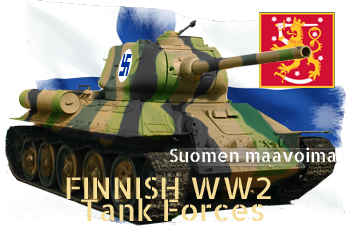Finnish Military History
The Finns have been fighting since at least the Bronze age (1500-500BC) with evidences of hill forts, swords and battle axes being found at numerous sites across the country. Finland and its people have been mentioned in Nordic Sagas, Germanic/Russian Chronicles and local Swedish Legends.When the area now known as Finland was absorbed into the Swedish Empire in 1352, its people were also absorbed into its military apparatus. Until the end of the Swedish era of Finland in 1808, Finnish soldiers had fought in at least 38 wars of note for Sweden, whether they be during the power struggles of the Swedish Royals or in wars between Sweden and other nations.
After the 1808-1809 Finnish War, Finland was given up by Sweden to Russia. Russia formed Finland as ‘The Grand Duchy of Finland’, which allowed it a degree of autonomy. In this period, Finland’s first first indigenous military units were formed, first in 1812, before culminating in a fully separate territorial style military between 1881-1901. During this time, one rifle battalion was given Guards status and fought during the Polish and Hungarian uprisings (1831 and 1849 respectively), as well as in the Russo-Turkish war of 1877-78. Finns garnered a reputation for military professionalism and stubbornness.
By the turn of the 20th century, troubles within the Russian Empire, coupled with a rise in Finnish national revival, sowed the seeds for an independent Finland. Between 1904 and 1917, paramilitaries started to form within Finland, with the goal of Finnish independence. After gaining its independence in 1917, Finland was plunged into a civil war between the ‘Red Guards’, consisting mainly of Communist and Social Democrats, and the ‘White Guards’, consisting of Republicans, Conservatives, Monarchists, Centralists and Agarians. After over 3 months of bitter fighting, the Whites won, with many Reds escaping across the border into Russia.
After the Civil War, the Finnish Army (Suomen Armeija) was formed. This force was based on conscription and, despite a growing economy, was poorly equipped. What it lacked in equipment it made up for with professionalism and ‘Sisu’ (a word roughly translated to stubborness and guts). Between its birth in 1918 to present day it saw itself involved in 3 major conflicts, the Winter War (1939-40), the Continuation War (1941-1944) and the Lapland War (1944-45).
Birth of the Finnish Armored Corps
The first armored vehicles in the service of the Finnish military were a handful of Russian armored cars supplied to the Red Guards which were captured by the Government supported White Guards. These were the British produced Austin Model 1917 and the Anglo-Italian produced Armstrong-Whitworth Fiat. The Finnish Armored Corps can trace its origin to 1919 with the formation of the Tank Regiment (Hyökkäysvaunurykmentti) on the 15th of July at Santahamina Island near the capital of Helsinki. With the regiment of men sorted, it was time to get the tanks sorted and an order was placed for 32 French Renault FT tanks. These arrived from Le Havre in Helsinki in early July, complete with six Latil tractors with their trailers, and were issued to the Tank Regiment on the 26th of August 1919.In the inter-war years, the Finnish military struggled to acquire more funds to modernize its forces. At the turn of the 1920’s, coming into the 1930’s, a second major procurement programme was started. This saw the Finnish military build itself two large armored ships, buy several modern aircraft and look at the market for new armored vehicles. In June 1933, the Ministry of Defence placed an order for three different British tanks; a Vickers-Carden-Loyd Mk.VI* tankette, a Vickers-Armstrong 6-ton tank Alternative B, and a Vickers-Carden-Loyd Model 1933. Vickers also sent a Vickers-Carden-Loyd Light Amphibious Tank model 1931.
All 4 tanks were put through a set of tests, but the Light Amphibious Tank performed so poorly in the trials that it was returned after only 17 days. The two Vickers-Carden-Loyd models were put into training use and the Vickers-Armstrong 6-ton tank was chosen to replace the obsolete FT’s as the main tank of the Finnish Armored units.
Thirty-two 6 Ton tanks were ordered on the 20th of July 1936 with the delivery spaced over the next 3 years. Due to budget constraints, all models were ordered without tank guns, optics or radios. Unfortunately, due to issues, the deliveries were delayed and the first 6-ton tanks didn’t arrive in Finland until July 1938 and the last came soon after the hostilities between Finland and the USSR ended in March 1940.
Also in the inter-war years was the formation of the Armoured Detachment (Panssariosasto) of the Cavalry Brigade (Ratsuväkiprikaati). This started on the 1st of February 1937 after successful trials of the Landsverk 182 Armoured Car, which was bought in 1936.
Winter War
On the 30th of November 1939, Soviet forces crossed the Finnish border and started what would soon become known as The Winter War (Talvisota). The Red Army started the campaign with over 2,500 tanks of various types. Finland, for comparison, only had 32 obsolete Renault FT’s, 26 Vickers 6 ton tanks (all without any weapons) and two training tanks, a Vickers-Carden-Loyd Model 1933, and a Vickers-Carden-Loyd Mk.VI*. On top of over 2,500 tanks, the Soviet Red Army deployed over 425,500 men and half the Red Air Force. The odds were overwhelmingly in the favor of the Soviets and it looked like the writing was on the wall for Finland with its almost non-existent tank force, 250,000 man army and just 20 days worth of operational supplies.By using their knowledge of the land, independent thinking, marksmanship and other tactical advantages, the Finns managed to not only slow the Soviet advance but eventually stall it and even eliminate several divisions (such as the legendary Battle of Suomussalmi). Due to the vastly superior numbers and firepower of the Soviets, the Finns only real tactic was to encircle and chop the Soviet formations into manageable pieces. These movements soon became known as “Motti” (a Finnish word for a cut size of wood) and by using it they could effectively manage their forces and systematically defeat Soviet forces many times their size.
Soviet T-26 light tanks and GAZ-A trucks of the Soviet 7th Army during its advance on the Karelian Isthmus, December 2nd, 1939. Source: Wikipedia
Despite the issue with Finnish tanks, there was one Finnish deployment of tanks, at the now infamous Battle of Honkaniemi. By using the only operational tanks in the Finnish inventory, the 4th Company of the Panssaripataljoona (Tank Battalion) was deployed with 13 Vickers 6-ton tanks (having been quickly armed with tank versions of the 37mm Bofors) to help retake the important area. Unfortunately, the operation was a disaster. Only 8 tanks managed to get to the jump-off point in working order, then the Finnish artillery shelled their own forces, then the attack was rescheduled before finally launching at 0615 hours on the 26th of February. A combination of inexperienced tank crews, the lack of armor-infantry coordination training, poor communications, and the superior enemy forces doomed the attack to failure. The result was the loss of all 8 tanks, as well as 1 crewman killed, 10 wounded and 8 missing.
The war came to an end on the 13th of March 1940, with the Finns managing to successfully hold the Soviets at bay for over 105 days. Ultimately though, the odds were just too much and they had to cave to the demands of the Soviets which saw them lose over 11% of their pre-war landmass.
Interim Peace and the Continuation War
Finland learned a lot of lessons from the disaster at Honkaniemi. In line with this, they created better tactics, concentrated on armor-infantry cooperation, and reformed the Armored Battalion. They had also acquired nearly 200 tanks of various types as war booty during their struggle with the USSR. Many of these were repaired and put back into service.After some very tense times, including harsh demands from the USSR, a food shortage, and domestic issues, Finland, through the promise of regaining its lost territory, was brought into the fold of Germany and their plan to launch an invasion of the USSR (Operation Barbarossa). On the 26th of June 1941,Finland declared war on the Soviet Union in response to Soviet aircraft carrying out Bombings on their airfields. Soon after the Finns launched their offensive against the USSR and the Armored Battalion helped lead the way through East Karelia until the campaign was halted after achieving its objectives in December of that year. Armored forces played a crucial role in the capture of Petrozavodsk (renamed Äänislinna) by helping to cut off retreating Soviet Forces.
While the Armored Battalion was supporting the Finnish assault of East Karelia, the main bulk of the Finnish Army was retaking its former lost territory. Soviet tactics consisted of holding consecutive lines of increasing strength to wear down the Finnish advance, while the Finns countered by large-scale ‘infiltrations’ through the heavy forests to appear on the flanks or behind the Soviet lines. A month after the Finns had launched their assault on the Karelian Isthmus, the Finnish flag was flying again over the old capital of the region, Viipuri. By the end of September, the Finns had retaken all former lost territory as well as some more strategically viable areas of Soviet territory on the Isthmus before settling into a defensive posture. A stop to all offensive operations by the Finns was ordered by Field Marshal Mannerheim on the 6th of December 1941.
More tanks were being added to the Finnish inventory as they overran Soviet positions and soon the Armored Battalion was large enough to be expanded to a Brigade (10th of February 1942), which included such tanks like the KV-1 and early T-34’s.
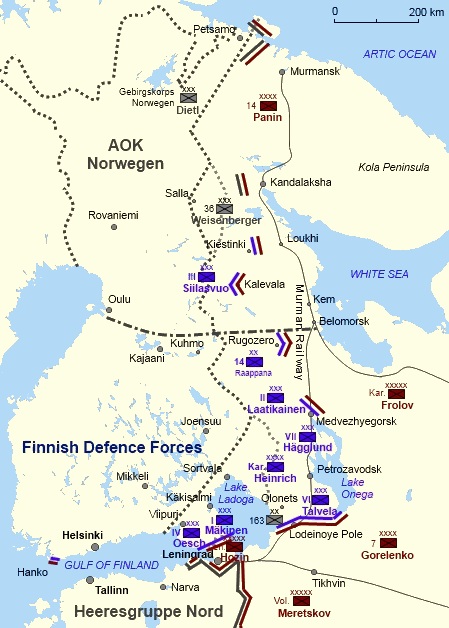
The front at the end of Finnish offensive operations in December 1941. There would be little movement of the lines until the Soviet offensive in the Summer of 1944. Source: Wikipedia
From the beginning of 1942 to summer 1944 saw the Finnish Front settle down to a trench-like war, with very little offensive action taken. This respite allowed the Finnish military to reduce its numbers and reorganize itself into a less straining burden upon its economy. The 30th of June 1942 saw the formation of the Panssaridivisioona (Armored Division) with the Armored Brigade combining with the ‘elite’ Jaeger Brigade to form a powerful offensive and reserve force. The Division saw itself expand and modernized with vehicles like the Landsverk Anti-II, StuG III’s and Panzer IV’s. There was also experimentation like the BT-42 Assault Gun, BT-43 APC, the ISU-152V and, probably the most successful, the T-26E.
It was during the relatively quiet period of 1942-early 1944 that the holes in the German-Finnish coalition started to show. Finland dragged its heels when repeatedly asked to provide support for the German assault in Northern Finland against Murmansk. The Siege of Leningrad was a particular thorn in Finnish-German relations, as the Finns (especially Marshal Mannerheim) had little interest in launching an assault against the great city. Historians have argued that this reluctant on part of the Finns helped save the city from capture.
In the Summer of 1944, just before the Normandy Landings, the Soviets launched a massive offensive with over 450,000 men and about 800 tanks which caught the Finns off guard and pushed them back several hundred kilometers before they could be stalled. The main reason was that many men were not recalled from their homes and so the army was in a reduced and unready state. The Armored Division formed the ‘firemen’ of the Finnish Forces, rushing from one threat to another. Unfortunately, as most of their tanks were of an obsolete early war design, they suffered heavy losses and only the StuGs and handful of T-34/85’s (seven having been captured between June and July 1944) stood much of a chance against the Soviet onslaught.
However, the Armoured Division played a vital role at the Battles of Tali-Ihantala, especially the Rynnäkkötykkipataljoona (Assault Gun Battalion) whose StuGs claimed 43 Soviet AFV’s for the loss of two of theirs. The contribution of the Armored Division, alongside that of the whole Finnish Army deployed at Tali-Ihantala, essentially blunted the Soviet assault and allowed everyone to come to the negotiation table and find a way out. A ceasefire came into effect on the 5th of September 1944.
Lapland War
Part of the terms for the cessation of hostilities between Finland and the Soviet Union was that Finland was to demand the withdrawal of all German troops from their territory by the 15th of September and, after this deadline, they were to disarm them and hand them over to the USSR, by force if necessary.The two former Nations-in-Arms attempted to make the withdrawal as peaceful as possible but under the intense scrutiny of the Allies, especially the USSR, eventually blows would be exchanged. Luckily for Finland, the Germans made the first move by launching an ill-fated attempt to capture the important Island of Suursaari. This saw the former enemies, Finland and the USSR, cooperate together to defend the island against an invasion force of 2,700 Germans. By the end of the day’s fighting, the small Finnish garrison, with Soviet fighter support, had caused 153 casualties and took 1,231 prisoners, as well as numerous items of equipment. With this incident, the next move was the remove the main German force from the north of Finland.

A map of the Lapland War and the major clashes. Source: https://lazarus.elte.hu
The Armored Division formed part of the force that would push the Germans out of Lapland, arriving in the city of Oulu between the 22nd and 25th of September. The Assault Gun Battalion and the 5th Jaeger Battalion were ordered to disarm German troops in the town of Pudasjärvi. The Battalion’s vanguard arrived, led by Major Veikko Lounila, at the crossroads just outside of the town and encountered a rearguard of the 7th Mountain Division. Major Lounila demanded their surrender but was refused and a firefight broke out. The short exchange of fire ended with no Finnish casualties but 2 dead Germans, 4 wounded and 2 prisoners. A ceasefire was called and Major Lounila again demanded the Germans in Pudasjärvi surrender. He was refused again but instead of launching an assault, he ordered his battalion to adopt defensive positions. Small exchanges of fire occurred for the next two days until the Germans withdrew across the Ii river and the 5th Jaeger Battalion occupied Pudasjärvi. This incident was seen as the break in the cordial relations between Finnish and German troops in the North of Finland and the Lapland War began in earnest.
A small contingent of T-26E’s was sent with the amphibious assault on Tornio and it would be one of these T-26E’s that would score the last Finnish tank on tank kill to date. Panssarimies Halttunen lined up his T-26’s 45mm gun and fired at a French tank under German Command of Panzer-Abteilung 211, which was disabled and soon abandoned. After the liberation of Tornio, the German resistance became less and less.
Finnish troops, supported by tanks, pushed towards the region capital of Rovaniemi and launched their attack upon the city. Skirmishes occurred on the outskirts of the city as the Germans attempted to evacuate the city but in the confusion, an ammunition train in the yards exploded causing widespread devastation to the area. The Finns blamed the Germans of deliberate destruction of the city, while the Germans countered with accusations of Finnish commandos or an uncontrollable fire that caught the train. Either way, when Finnish troops finally entered the city on 16th October, about 90% of the city was in ruins. After Rovaniemi, the fighting turned more into skirmishes between small units. The rough, heavily forested terrain of Lapland is not good country for tanks and so the Armored Division’s tanks were of more use in a supply and ambulance role, helping to keep the Finnish Army moving towards its goal of a wholly liberated Finland.
Another part of the negotiations between Finland and the USSR was that Finland would immediately reduce its military forces. This eventually affected the Armored Division, with it being pulled out of combat operations at the end of October, reduced to a Battalion on the 21st of November 1944 and eventually all tanks were returned to Parola in December. Despite its short combat history, the Finnish Armored units performed well, earning high praise from both their allies and enemies. They showed that even outdated combat systems can be effective if used right and, in the Finnish view, what the right amount of ‘Sisu’ can do. By the end of Finland’s wars, 4,308 men of the Division had become casualties of war.
Finnish Tanks
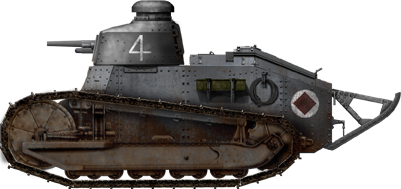
Finnish Koiras (14 in service). This was the gun-armed version. The MG armed was named “Naaras”.
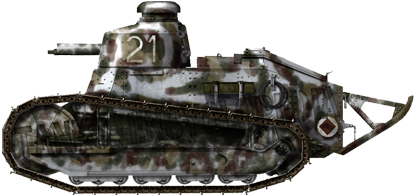
Machine-gun armed version of the Renault FT in Finnish service, the Naaras (18 in service). Most were dug in as pillboxes in the defensive lines, negating the mobility and armor issues compared to Russian tanks.
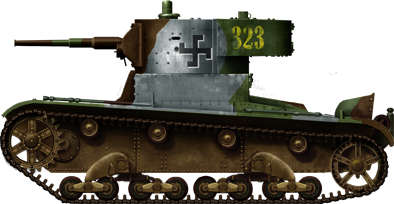
T-26s were the most abundant of all the Soviet tanks and the most captured during the Winter War. 47 were repaired, of which 34 were pressed into service on the front line, mildly appreciated since their engine was more reliable than that of the Vickers model. Some T-26As (twin turreted) and OT-26s were converted with spare 45 mm armed turrets. Their service time was limited and most had been retired at the end of the summer of 1941.
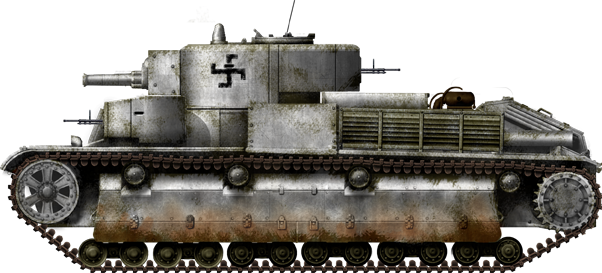
T-28: These comparatively rare infantry tanks were also heavily engaged in the Winter War. The few models photographed under Finnish colors had extra protection for the gun mantlet, like this T-28M in winter paint.
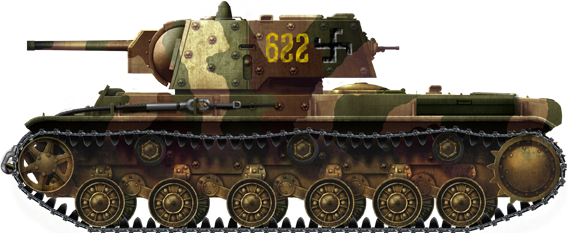
KV-1: This 50-ton monster became operational just before the Continuation War. Some were captured in 1941-42. However, a single prototype was also tested by the Soviets in December 1939 in the Winter War with the 91st Tank Battalion.
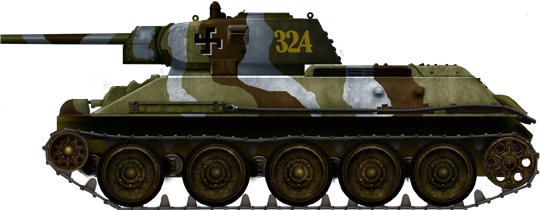
T-34: The most prolific tank of all time was not available before the end of the Winter War. Therefore like the KV-1, almost all were captured in 1941-42. However, some T-34/85s were also captured.
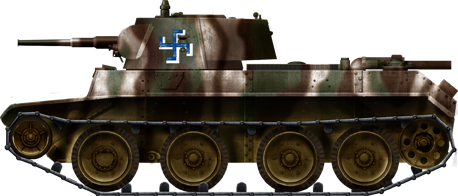
BT-7: This “fast tank” was the second most current Soviet tank during the Winter War and proved unable to cope with the Finnish terrain and deep snow. Many were captured and some were even transformed into the first and only WW2 Finnish tank, the BT-42. Two were active in the summer of 1941 as the “Christie detachment” or heavy tank battalion (Raskas Panssarijoukkue), which also counted three BT-5s (R-97, 98 and 99).
BT-5: These “fast tanks” were also captured in some numbers (900 were committed by the Red Army). After September 1941 (when the Christie detachment was disbanded) BTs were no match for the new generation of Soviet tanks. There is no record of captured BT-2s, although some fought in the North Ladoga lake sector. In fact, many more Soviet tanks could have been reused by the Finns, but their fate in the “Mottis” (pockets) prevented that. Indeed they were often dug in in low turret position and the Finns had no efficient towing capabilities, plus most had been already damaged beyond repairs by Molotov cocktails and satchel charges. BTs in general were considered having an even lower technical reliability than T-26s and limited range because of a high fuel consumption. 62 were listed in the Armor Centre repair facility, but only 21 were fully repaired, stockpiled and eventually scrapped.
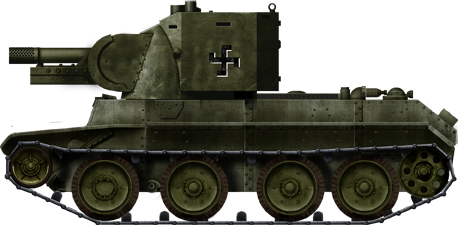
BT-42: Properly speaking, these were captured BT-7 modified to carry the British QF 4.5-inch howitzer howitzer in a custom-built superstructure. Top heavy and unstable, the BT-42s proved unable to penetrate the thick sloped armor of standard Soviet tanks in 1942.
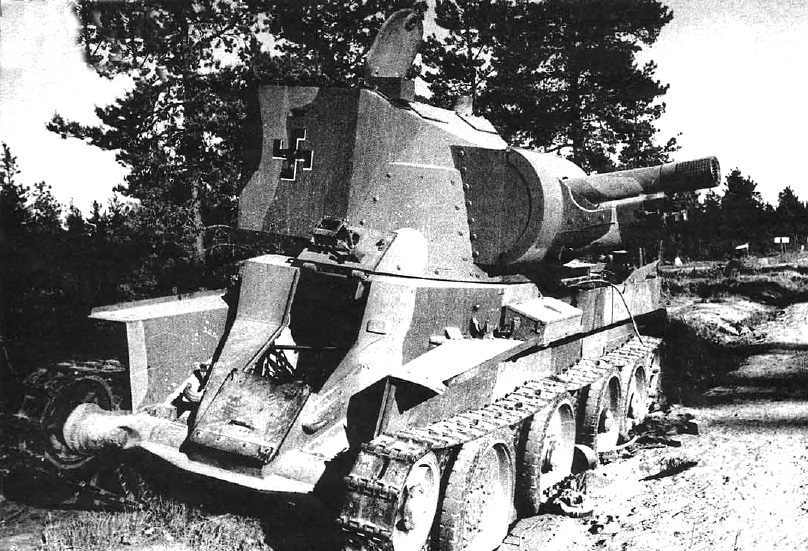
Disabled BT-42. One of the few Finnish-built tanks was a risky compromise that did not pay off due to the numerous shortcuts that had to be done in order to be completed. On paper, a fast tank armed with a 114 mm gun seemed like quite a good idea.
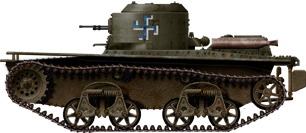
Finnish-captured T-38. T-37A/T-38: Many of these amphibious light tanks were also captured.
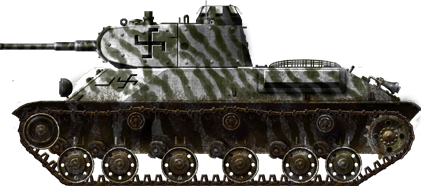
T-50: A single one of these rare and promising light tanks was captured and pressed into service, apparently up-armored, known as “Niki” and attached to the heavy tank company in the winter 1942-1943..
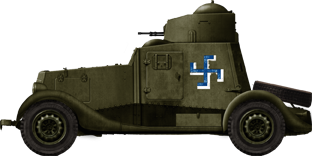
FAI: These already obsolete armored cars were of no help in the snow and mud. Most captured were put to good use for patrols and “battle taxis” in the summer of 1941.

SU-types (SPGs): The list of Soviet Self-propelled guns reused by the Finnish forces includes SU-76s, SU-152s and even two ISU-152s.

WW2 Tanks




























WW2 tanks posters

All Tiger tanks liveries.

Panther liveries and variants

WW2 Armour - All tanks











Tanks aces and single tanks series

Find more there

Museums, Movies, Books & Games
The Tanks and Armor in pop culture
Tanks and armored vehicles in general are only really grasped when seen first person: The mass, the scale, it's all there. Explore also the way tanks were covered in the movie industry, in books and in video games.Movies:
Best tanks movie on warhistoryonline.com
On imdb.com
On bestsimilar.com/
miltours.com
liveabout.com/
watchmojo.com
Video Games:
pcgamesn.com
historyhit.com
levvvel.com
vg247.com/best-tank-games
mmobomb.com/
alienwarearena.com

